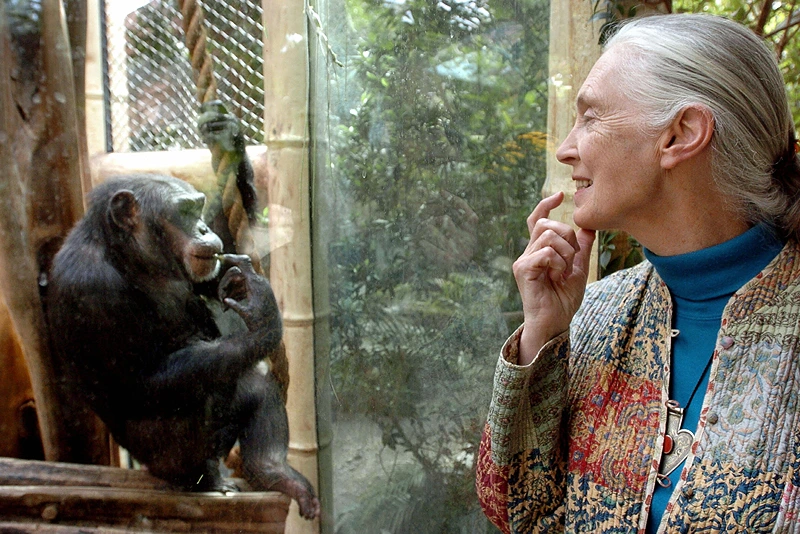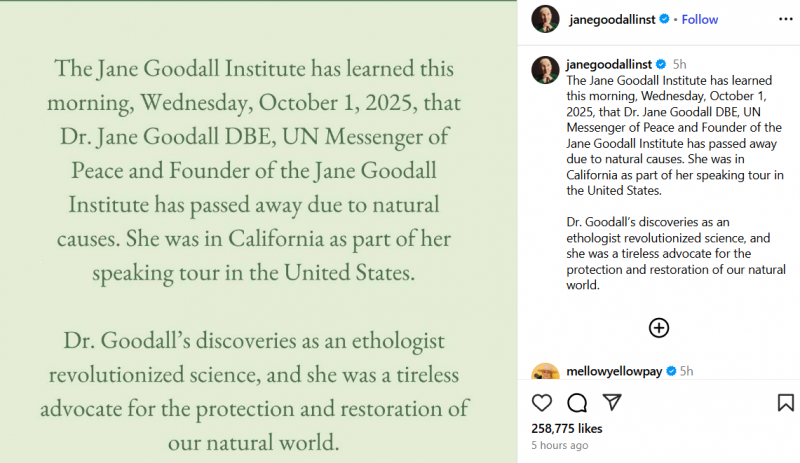


OAN Staff Katherine Mosack and Brooke Mallory
4:30 PM – Wednesday, October 1, 2025
Jane Goodall, the famous anthropologist, conservationist, and primatologist, has died at age 91.
The Jane Goodall Institute issued a statement on Instagram on Wednesday, explaining that she had died of natural causes while in California on a speaking tour in the United States.
Goodall was born on April 3, 1934, in Hampstead, London, United Kingdom.

“Dr. Goodall’s discoveries as an ethologist revolutionized science, and she was a tireless advocate for the protection and restoration of our natural world,” the institute said.
Goodall’s passion for animals began at a very young age, as she was inspired by books such as “Doctor Dolittle” and “Tarzan,” which she began reading at 10-years-old.
In 1957, Goodall relocated to Kenya to work as a secretary for anthropologist Louis Leakey, who would later sponsor her pioneering primate research in London, England.
In 1960, She first traveled to Tanzania when she was 26-years-old to begin her research on chimpanzees in the wild at Tanzania’s Gombe National Park. Goodall demonstrated that primates can exhibit human-like behaviors, including tool use. Unlike most scientists of her era, Goodall gave the chimpanzees personal names, such as David Greybeard, Flo, and Fifi, rather than assigning them numbers.
Other notable behaviors Goodall documented at the time:
- Chimpanzees hunt and eat meat — though they were previously believed to be vegetarians
- They show affection, cooperation, and play — similar to humans.
- They wage violent territorial disputes — challenging the prior belief that aggression was uniquely human.
She married Baron Hugo van Lawick, Dutch wildlife filmmaker and photographer, in 1964, at age 29.
They met after National Geographic sent Hugo van Lawick to document her work. The two married in 1964, but after a decade together their careers led them in different directions — van Lawick to the Serengeti, over 500 miles away, and Goodall to continue her research at Gombe — and they eventually divorced in 1974.
At 31, Goodall earned her PhD in ethology from the University of Cambridge, drawing on her first five years of research at Gombe for her dissertation. After her first marriage ended in 1974, Goodall then married Tanzanian National Parks Director Derek Bryceson — the following year.
Tragically, Bryceson died of cancer in 1980, after which Goodall chose not to remarry, dedicating herself fully to conservation and advocacy.
In 1977, as Goodall was in her forties, she founded the Jane Goodall Institute (JGI) in Washington, D.C., with offices in 25 cities worldwide. The organization’s goal is to “use the latest scientific discoveries and technologies to solve some of the world’s toughest conservation challenges.”
JGI protects chimpanzees and other apes in areas across Tanzania, Uganda and Congo. They also have a youth leadership program that’s active in nearly 100 countries, called Roots & Shoots.
In the 1980s, Goodall became increasingly vocal about the capture of chimpanzees for circuses and medical research. In 1986, she left Gombe to witness the conditions of laboratory chimpanzees firsthand, marking a turning point in her career toward global advocacy. After being appointed a United Nations Messenger of Peace in 2002, she continued championing conservation and animal welfare well into her 80s and 90s.
Goodall is survived by her son, Hugo Eric Louis ‘Grub’ van Lawick, who grew up among African wildlife and now lives in Tanzania as a boat builder.
Stay informed! Receive breaking news blasts directly to your inbox for free. Subscribe here. https://www.oann.com/alerts
What do YOU think? Click here to jump to the comments!